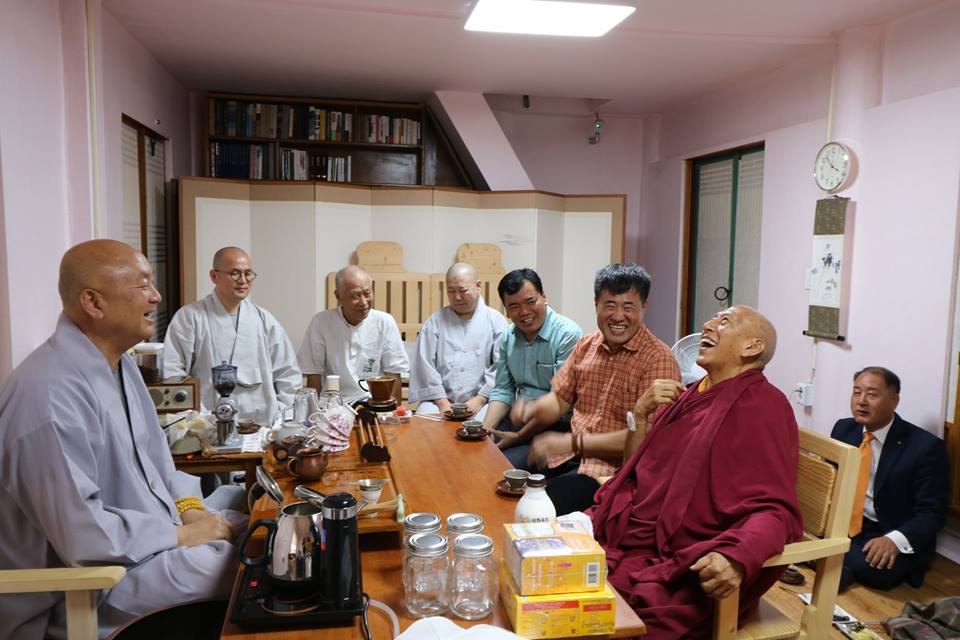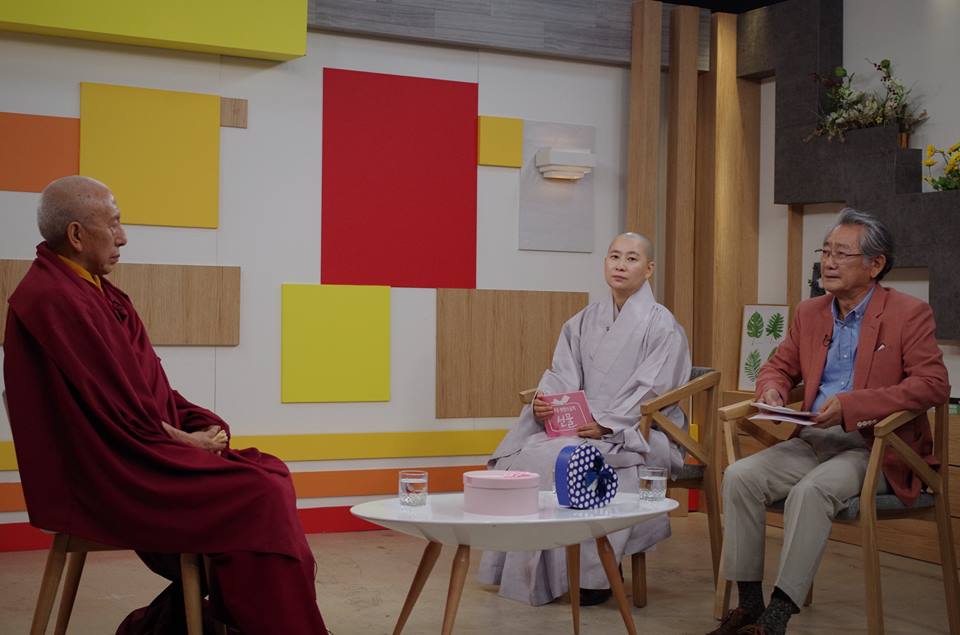Teachings in South Korea
at the request of the devotees in the southern peninsula
(from 4 August 2017 till 15 August 2017)
On 3 August 2017, His Eminence Prof. Samdhong Rinpoche departed Dharamshala, and via Delhi, arrived at Seoul Incheon International Airport, South Korea, in the morning of 4 August 2017. His Eminence Rinpoche was welcomed there by Geshe Namkha, who then accompanied His Eminence Rinpoche to Gimpo Airport. From there, His Eminence Rinpoche took another flight and arrived at Ulsan airport, at about midday, where the local Buddhist devotees accorded a revered welcome. His Eminence Rinpoche thereafter arrived at Gil sang sa Temple.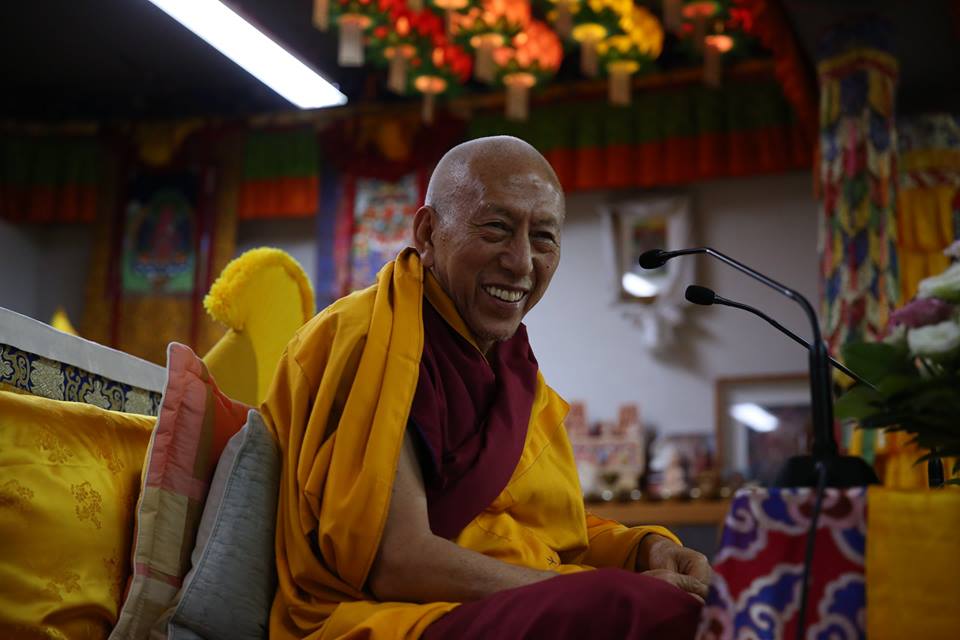
On 5 August 2017, His Eminence Rinpoche took part in the inauguration ceremony of the Temple, and gave a talk, in which His Eminence Rinpoche pointed out: It would not be right to follow the Buddha’s teachings by blind faith, rather one needs to do study and do contemplative reflection; if the Kagyur (bkaḥ-ḥgyur; Buddha’s Words in Tibetan translations) and Tangyur (bstan–ḥgyur; Commentarial texts in Tibetan translations) are translated in the local language, it would be a service to the teachings, and of far-reaching benefits to sentient beings; how greatly contributive the Great Abbot Shantarakshita had been to Tibet; how Buddhism made way into Tibet, and how of a great correct standard the Tibetan translations were; and so forth. His Eminence Rinpoche’s talk was translated into Korean by Mr Yang sung kyu.
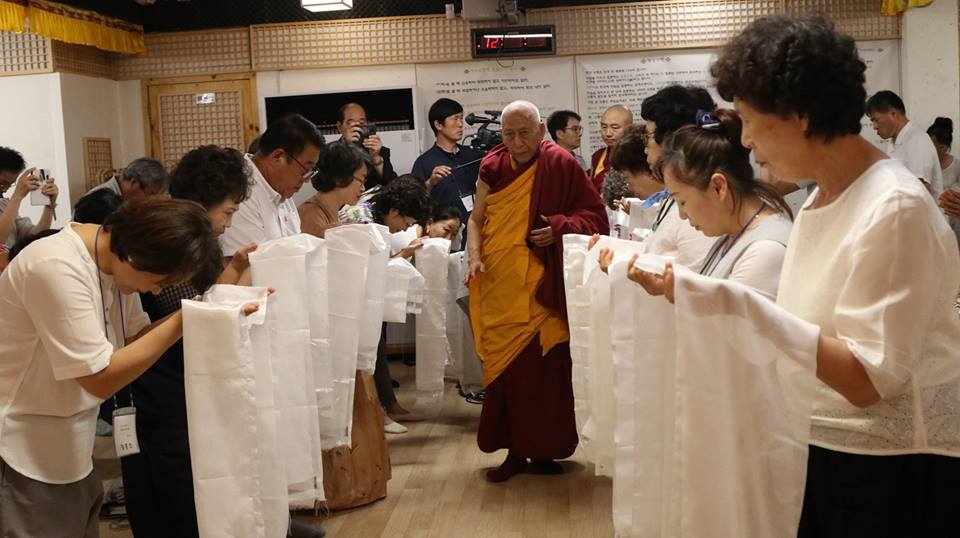
In the evening, His Eminence Prof. Samdhong Rinpoche gave a commentarial teaching, to the faithful there, on Atisha’s text The Lamp of the Path to Enlightenment. At the start, His Eminence Rinpoche remarked that the commentarial teaching this time was not in the mode of Teacher-disciple, instead as a tutorial in a class on a given subject.
His Eminence Rinpoche explained background details on the text, a biographical introduction on Atisha, the conversation between Atisha and the great translator Lochen Rinchen Sangpo; continuing on, His Eminence explained: The reason why the Buddha did not give teachings for seven weeks, subsequent to having attained enlightenment; the turning of the wheel of teachings on the Four Truths; teachings and practices are for achieving liberation and the state of omniscience, not for aims of this life; how the three categories of teachings (tripitaka) are inclusive to the path of the three capable practitioners (the small, middling and great); the three trainings taught by the Buddha can be practised by all in accordance with one’s mental capabilities.
After explaining and advising thus as the preliminary to the commentarial teachings, His Eminence Rinpoche gave commentarial teaching from the beginning of The Lamp of the Path to Enlightenment. In explaining about “the least capable person,” the small capable practitioner, His Eminence Rinpoche gave the insight that those who do things for this life’s interests do not even qualify as “small capable person,” that they are not even “capable person”. In this first session of the commentarial teachings, His Eminence Rinpoche completed the section on Intermediate Capable Person.

In the morning of 6 August 2017, His Eminence Prof. Samdhong Rinpoche continued the commentarial teaching on The Lamp of the Path to Enlightenment. Explaining the practices of a great capable person, His Eminence Rinpoche advised: The need to be preceded by having generated renunciation, for arising of great compassion; as regards generating of the Mind of Enlightenment (bodhicitta; cittotpad), there are two methods—the seven-parts cause and effect instructions, and equalising and exchanging of self (self-cherishing) with others (cherishing others), and the sequence of the meditation on the two is to start training from equanimity; the goal to achieve is the welfare of other sentient beings, the interest in others’ welfare, not Buddhahood; for the collection of pristine consciousness to be powerful, one needs to accumulate the collection of merits. His Eminence Rinpoche thus explained the text in considerable details.
In the evening, at the request of the lay devotees, His Eminence Rinpoche bestowed Upasaka and Upasika lay vows, with preliminary teachings. Mr Yang sung kyu translated these teachings into Korean language.
In the morning of 7 August 2017, His Eminence Prof. Samdhong Rinpoche departed from Ulsan city. On the way, His Eminence Rinpoche visited Tong da sa Temple, which houses a relic of the Buddha. In the evening, His Eminence Rinpoche arrived at Seok cheon sa Temple, in Yeosu city. His Eminence Rinpoche discussed with the Temple’s Abbot and staff members the project on translating Kagyur (bkaḥ-ḥgyur) and Tangyur (bstan–ḥgyur) into Korean language; at their request, His Eminence Rinpoche gave detailed guidance advice on translations.
In the morning of 8 August 2017, His Eminence Prof. Samdhong Rinpoche gave a teaching at Seok cheon sa Temple. His Eminence Rinpoche touched upon the practices of the three capable persons; the way of practising the teachings; the importance of motive and dedication prayers; although the number of humans are many, rare are those who have the thought and the leisure to practise the teachings; the great goals can be achieved through this human life, the meaning of “great goals” is to be understood as interests of beyond this life; it would be a great loss to let go to waste such a potent human life; even animals are capable of achieving things of this life.
Continuing on, His Eminence Rinpoche advised: The need to understand the differences of the three capable persons—the small, middling and the great—and the need to do practices of all three, which one can do so; practising of the teachings is not merely reading a text, reciting a mantra, and making supplication prayers, instead it is to direct the mind away from attachment, hatred and ignorance, and thus make improvement to one’s mind; if one has intention and effort, one is able to traverse to liberation and the state of omniscience.
His Eminence Rinpoche continued: To make changes to one’s mind, at first, one needs to rely on a qualified teacher, and know the teachings; if one has a good awareness of death and impermanence, one’s all three parts—body, speech and mind—would accord with the teachings; how rare it is for us to make a time, out of twenty-four hours, to practise the teachings; but when it comes to doing non-virtuous actions, how even with a small non-virtuous action we do, we do so with much intensity/power, that it is done with all parts complete—preparation, the actual doing, and the end thinking; whereas, when doing virtuous actions, even with a major virtuous action, we do so with incomplete preparation, actual and the end, which makes the action so small in power.
Further on, His Eminence Rinpoche advised: We do not have the confident assurance that we would certainly attain a happy rebirth next time, rather we are surrounded by causes and factors for heading to bad rebirths; the ability to rescue from our such situation is with the Three Rare Supreme, the Three Jewels—as such, one needs to generate a pure going-for-refuge; the Dharma Jewel (the Jewel of Teachings) in the context of the small capable person is the morality of eschewing the ten non-virtues; non only one does not commit the ten non-virtues, one needs to generate the thought-to-eschew in one’s mind, which is then the actual stages of the path of the small capable person.
Continuing onto the intermediate capable person, His Eminence Rinpoche explained: Being born once in a happy rebirth, there is still the danger of falling into the bad lower rebirths; as such, one needs to rely on a means to not having at all to take lower rebirths; even with a life in a happy higher rebirth, there are numerous sufferings—of birth, ageing, sickness, death, and so forth; the experiencing of cyclic/samsaric sufferings are the results of non-virtuous actions, which in turn are factored by afflictions, the principal ones being attachment, hatred and ignorance; it is from ego-grasping ignorance, attachment and hatred arise; so for them to not arise, one needs to eschew ego-grasping ignorance, which can be done so through relying on wisdom realising selflessness.
On the practices of the great capable person, His Eminence Rinpoche explained: Through the practices of the three trainings, although one may become freed from the cycle of sufferings, yet if one ignores the welfare of all mother sentient beings remaining in sufferings, it would be the lowest of mean behaviours—the reason for that is, there is not any sentient being who has not been one’s mother; if there arises in one’s mind a thought of a great compassion, there would arise the exalted-thought/universal responsibility thought working for others’ welfare; to accomplish others’ welfare is the goal, Buddhahood is the means for that; once the altruistic mind-of-enlightenment (bodhicitta) has been generated, one engages in accomplishing others’ welfare by the practices of the six perfections and so forth.
Thereafter, in advising in particular to the lay attendees at the teaching, His Eminence Rinpoche instructed: Since lay people do not have much time for practices, they are not able, by their circumstance thus, to do many things; as such, it would be good if they keep as the referent text any text of Lamrim (Stages of the path to enlightenment), and then slowly start from studying it; if one can transform into Dharma/spirituality anything one does in a day, one’s life becomes meaningful; from the time one wakes in the morning, one needs to, while recalling the Three Jewels, keep ahead the intention that one would engage least in non-virtues, and engage in as many that are virtuous; even when taking a wash, one needs to think ahead with the intention to have as few negative thoughts of attachment, hatred and so forth, and as many as that are virtuous—lovingkindness, compassion, and so forth; and in between, one recites sacred mantras; when visiting temples and so on, one needs to recall the excellent qualities of the Three Jewels, and admire in veneration through physical gesture of hand-palms brought together; when coming across someone tormented by sufferings, one needs to help, if one can, if not, at least generate compassion and pray for their wellbeing; with a good motive even if one says something pleasantly, vast merits can be accumulated; even if one offers a flower at the altar, the motive for it must not be aiming for a success in business, instead, the motive needs to be wide-ranging to include welfare of others; if it was aimed for a happy rebirth, it becomes a deed of a small capable person; if it was aimed for liberation, it becomes that of an intermediate capable person; if it was aimed for all sentient beings’ welfare, it becomes a deed of a great capable person; if the motive is with the presence of enlightenment mind (bodhicitta), vast merits would be accumulated.
To the lay, His Eminence Rinpoche further advised: When about to go to sleep at night, one does a review of the day’s actions, and if there had been more of non-virtuous actions, one think of them with remorse, and with a strong feeling, avows not to do so in future; if one finds there had been more of virtuous actions done, one rejoices on them, and thinks of doing more so in future; likewise, one needs to seal the virtues/merits with dedication prayers and prayers; the thought of remorse and the strong feeling are for the negativities to not increase, and dedication and prayers are for merits to not perish; then, one needs to direct one’s sleep to become of virtuous entity.
On these and other related practices, His Eminence Rinpoche advised in great details. Those receiving the teachings comprise of the Temple’s Abbot, the ordained members, and the general public. Mr Yang sung kyu translated the teachings into Korean language.
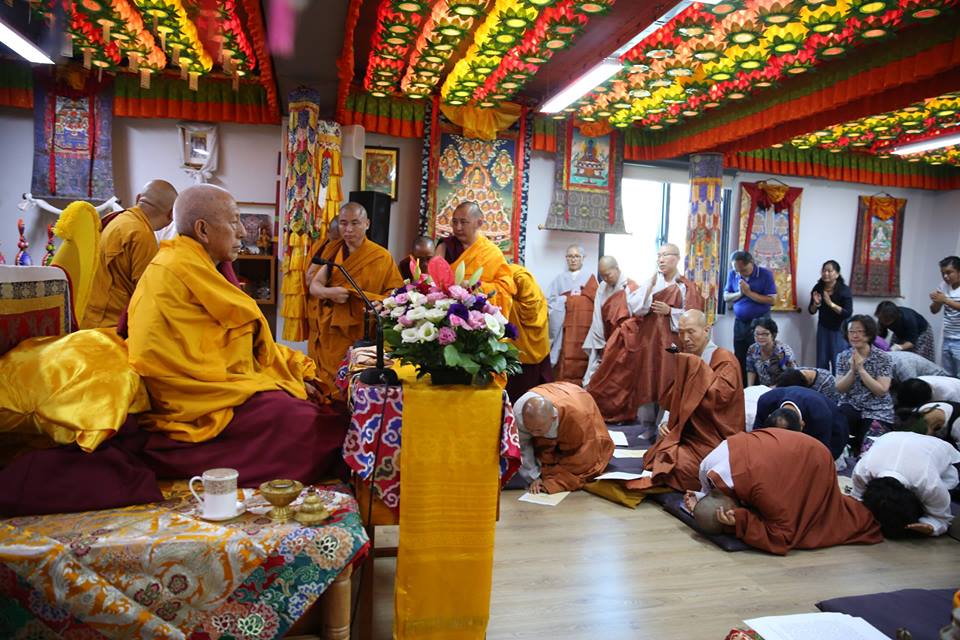
In the morning of 9 August 2017, His Eminence Prof. Samdhong Rinpoche departed Yeosu city. Upon arrival at Gwang seong Temple (also known as Korea Tibet Center), in Busan city, at around midday, His Eminence Rinpoche was welcomed by the ordained and the public of the area.
On 10 August 2017, at the request of the devotees, His Eminence Prof. Samdhong Rinpoche gave in the morning a teaching on Jey Tsongkhapa’s text Praise to the Buddha for Teaching Dependent Arising, in the temple of Korea Tibet Center. His Eminence Rinpoche explained that this text was composed independently by Jey Tsongtkhapa, not directly referencing with Indian commentarial texts; thereafter, His Eminence Rinpoche presented the text in outlines, followed by explanation on each of the verses.
Subsequent to that, His Eminence Rinpoche gave a commentarial teaching on Praise to Twenty-One Taras, and its transmission blessing. A large number of devotees came to receive the teachings. Ven. Ratoe Geshe Sonam, the In-charge of Korea Tibet Center, translated the teachings into Korean language.
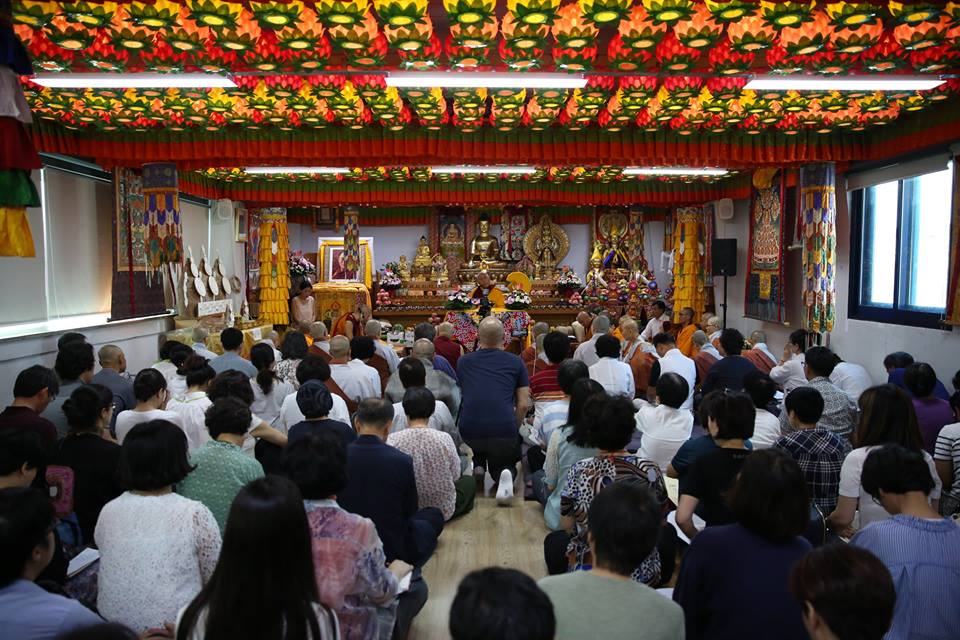
In the morning of 11 August 2017, upon departing by train the city of Busan, some devotees came to accord a revered see-off to His Eminence Rinpoche. At around midday, His Eminence Rinpoche arrived in the capital city Seoul.
In the morning of 12 August 2017, His Eminence Prof. Samdhong Rinpoche gave a commentarial teaching on The Essence of Wisdom, including the background details on the Sūtra, at the temple of Lābsum Shedupling (The Centre for Teaching and Practice of the Three Trainings). His Eminence Rinpoche began by remarking that the teaching this time would be as a Dharma discussion, that there was no need this time to approach it as a teacher-disciple relation.
His Eminence Rinpoche explained: There are some seven Indian commentaries on The Essence of Wisdom; Vimalamitra’s and Acharya Kamalashila’s commentaries appear as written in Tibet; the commentary written by the Nepali (Newari) teacher Vajrapani elucidates the Sūtra into Mantra (tantric) context, and in tenet view, it appears as asserting alayavigyana (the basis-of-all consciousnesses); Supragya’s commentary too appears to elucidate in Mantra context.
Thereafter, His Eminence Rinpoche explained each word of the text, by dividing it into three parts: the preliminary, the actual and the conclusion. Attending the teachings were a large number of devotees comprising of Tibetan ordained members, Korean monks and nuns, and lay faithfuls. Ven. Geshe Namkha, the In-charge of Lābsum Shedupling, translated the teachings into Korean language.
In the evening, His Eminence Rinpoche departed Seoul city. Upon arrival at Haengbok Seon (Happiness Zen Center), a nunnery, located in the foothills of Yongin, His Eminence Rinpoche was accorded a revered welcome prostration by the nuns and lay devotees of the area.
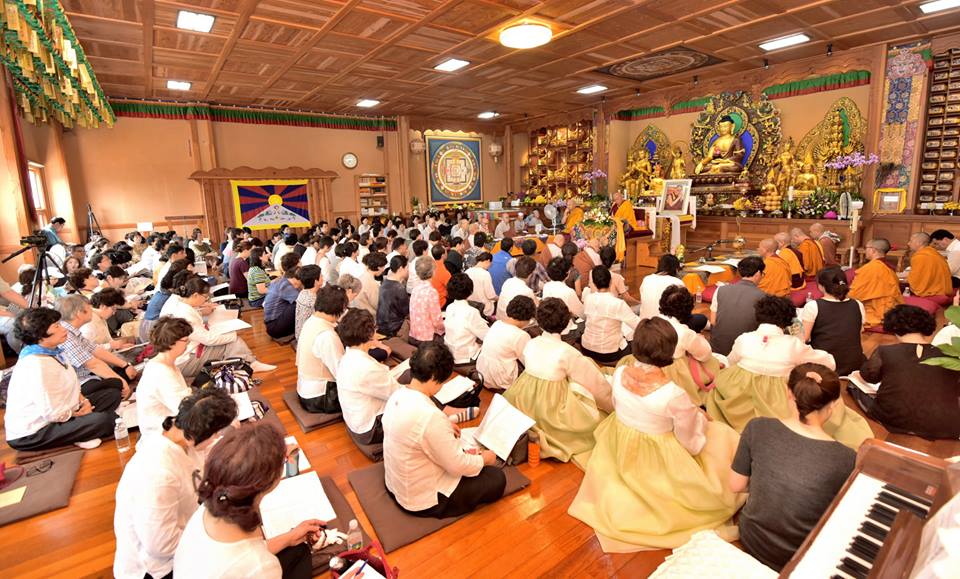
In the morning of 13 August 2017, His Eminence Prof. Samdhong Rinpoche gave a teaching, at the Nunnery, Haengbok Seon, on the requested theme of the way of practising the teachings. His Eminence Rinpoche instructed: The difficulty of attaining a human rebirth; of the variety of species of beings, humans are few—of them, rare are those with kind thoughts and interest in the teachings; that you all are not only born in a place where the teachings of the Buddha have flourished, more so that you have faith and reverence to the Three Jewels, do engage in practices, and have the thought to listen to the teachings, are the results of merits from past lives, as such, to not let go to waste, instead to utilise this life in good ways is a specific human responsibility; since humans do have individual thoughts, diverse tendencies and inclinations, there thus have emerged various religious systems, that a single system does not suffice; all religious systems are important; in the twenty-first century, in terms of people’s way of thinking in general, Buddhism is the most suitable and of most applicability.
Continuing on, His Eminence Rinpoche said: The purpose of religions is to remove sufferings and to attain happiness; even those who do not know a religion, or those who are non-believers, do have the thought to remove sufferings and to attain happiness, yet the ways of thinking are different; for example, a spiritual person views that sufferings are rooted in the inner mind, that from ignorance in the mind there arise attachment and hatred, from which there arise sufferings, and by improving the mind the ignorance can be removed—whereas, those who do not know spirituality, or are non-believers, they view sufferings as faults or lacking in the external material things, and that the solution is science and technology, through which material riches can be made abundant to remove the problems; they do not know that the mind can be transformed; although much material progress has been achieved, yet the sufferings of the sentient beings have not been removed; those who strive towards progress of the inner mind are able to lead a happy life, even though they lack in external material facilities, they are able to become a factor in bringing about happiness to others related.
His Eminence Rinpoche further advised: Since we are not only followers of the Buddha, we are as well followers of the Buddha’s Great Vehicle teachings, we need to put effort, from now on, even as beginners, towards bringing happiness to all sentient beings, through the mind of enlightenment (bodhicitta) and great compassion, the essence of the great vehicle path; if that is our responsibility, we must certainly know the quickest methods of removing sufferings, and of eliminating the most dire sufferings; the problems/challenges of the most grave nature in the twenty-first century are (1) increase in violence—war and danger of imminent war, terrorism, weapons of mass killing, and so forth; (2) the second problem is the inequality in riches, the gap between the poor and the rich becoming bigger and bigger each day, resulting in poverty of food and medicines for many; some have too much in abundance, resulting in conscienciousless consumption; (3) the third problem is that of environmental degradation—through economy/commercialism and science, the environment has been much degraded, the danger to humans and other species from global warming; (5) the fourth problem is disharmony among religions—that which is meant for achieving happiness becomes a cause for sufferings; the dangers being faced by all species of beings from these four.
In continuation, His Eminence Rinpoche advised: Akin to a physician able to prescribe the right medicine, after having understood the causes and factors of the disease, we too should recognise these four symptoms; to know so and to strive to remove the problems is our responsibility.
Thereafter, on the important of dedication prayers, His Eminence Rinpoche instructed: With a pure altruistic thought, if one makes a prayer, it would be greatly powerful; along with prayers, there has to be dedication; prayers and dedication alone are not sufficient, one needs to study the spoken words of the Buddha, the tripitaka, and try to generate in one’s mental continuum the realisations; since those earlier mentioned problems/challenges have come about from non-improved mind, one now needs to make transformation to the mind; Buddhism is a thing inside the thoughts, not as a material thing outside; not to mention about the ordained, even the lay need to do study and contemplative reflection; you need to retain without decline the tradition of meditation and practices extant here, and disseminate them to others as well.
In relation to the immediate preceding advice, His Eminence Rinpoche admired the secluded location of the Nunnery. Mr Yang sung kyu translated the teaching into Korean language.
In the afternoon, His Eminence departed Haengbok Seon, and arrived at Lābsum Shedupling, Seoul.
In the afternoon of 14 August 2017, Buddhist Broadcasting System (BBS) TV invited His Eminence Rinpoche for an extended interview on Tibet cause. The two interviewers are famous personalities in South Korea; the Director of the broadcasting station also called upon His Eminence Rinpoche.
In the afternoon of 15 August 2017, His Eminence Rinpoche departed from Seoul Incheon International Airport. After an overnight stay in Delhi, His Eminence Rinpoche took a flight from Delhi in the morning of 16 August 2017, and arrived in Dharamshala in the afternoon.
